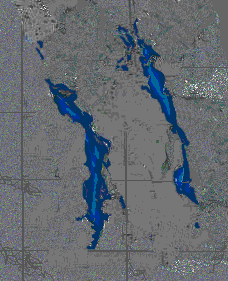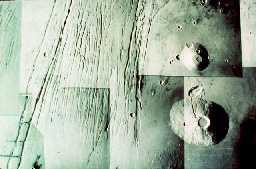Plate Tectonics
The following table discusses plate tectonics on Earth and Mars.
Earth

This animated picture shows seafloor spreading on Earth.
Click on image for full size version (40K GIF)
Image courtesy of NOAA/NESDIS/National Geophysical Data Center, Boulder,
CO.
This animation shows how seafloor spreading works on
Earth. The age of
the ocean floor in the Atlantic and Pacific Oceans is shown in colors -
red for young and blue for old. The
animation shows that the American continents are
separated from the Eurasian and African continents as time advances.
Red, young portions of the ocean floor are where fresh new crust is added
from the Earth's interior. Blue, old portions of the ocean floor are in
regions where the ocean floor drops down below a continent and
into the Earth - a process called "subduction".
|
Mars

This is a map of the entire Martian surface.
Click on image for full size version (123K GIF)
Image courtesy of NASA.
As the map above shows, the high areas of the
Martian surface (colored in red) are mainly in the southern
hemisphere of Mars. This would suggest that a single, large plate
has formed on Mars, with no later plate
tectonics. |
 Leave the tour and read more about
Plate Tectonics.
Leave the tour and read more about
Plate Tectonics.
 Leave the tour and read more about
the evolution of Mars.
Leave the tour and read more about
the evolution of Mars.
 Leave the tour and read more about
Plate Tectonics.
Leave the tour and read more about
Plate Tectonics.
 Leave the tour and read more about
the evolution of Mars.
Leave the tour and read more about
the evolution of Mars.













